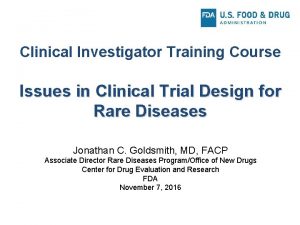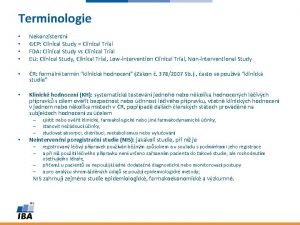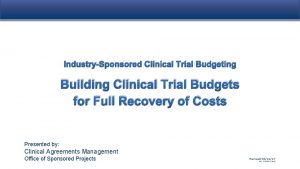Looking Forward FDA Perspective on New Clinical Trial











- Slides: 11

Looking Forward: FDA Perspective on New Clinical Trial Designs for LAA Occluders Rachel Neubrander, Ph. D Division of Cardiovascular Devices Office of Device Evaluation Center for Devices and Radiological Health (CDRH) rachel. neubrander@fda. hhs. gov CRT 2017 February 20, 2017

Disclosures • No conflicts of interest to report. www. fda. gov 2

LAA Occlusion to Prevent Ischemic Stroke • WATCHMAN approved March 2015 • LAAO registry launched December 2015 • CMS Coverage with Evidence Development finalized February 2016 Looking forward: • Development of new devices • Address other knowledge gaps www. fda. gov 3

New LAA Occlusion Devices: Framing Benefit – Risk in Pivotal Trials • Is the LAA occlusion procedure associated with an acceptable rate of device and procedurerelated complications? • Does the LAA occlusion device provide adequate protection from ischemic stroke? • In device vs. anticoagulation trials, is the avoidance of long-term AC following LAA occlusion associated with a reduced risk of major bleeding complications? 4

Potential Trial Designs New device: • OAC eligible patients: Randomized controlled trial (RCT) of investigational device vs. approved device or investigational device vs. OAC (particularly NOACs) • OAC unsuitable patients: RCT of investigational device vs. ASA/no treatment Iteration of approved device: • Dependent on the design change(s) • Consider alternative, least-burdensome trial design 5

OAC unsuitable patient population • Individuals with absolute and important relative contraindications to anticoagulation • Randomized trials needed to establish safety and effectiveness and define benefit-risk • Single arm studies using performance goals (PGs) not adequate • Ongoing ASAP-TOO trial adequately powered to address benefit-risk questions in this patient population 6

Safety and Effectiveness of Alternative Medication Regimens Post-LAA Occluder Implantation • Current WATCHMAN US DFU includes: – Warfarin + aspirin for at least 45 days – Aspirin + clopidogrel through 6 months • Alternative post-implantation regimens include: – DAPT alone (no warfarin) – NOACs • Well designed and conducted prospective studies needed 7

Leveraging LAAO registry infrastructure • Potential for more efficient utilization of resources – Post-approval surveillance of safety and effectiveness outcomes – Real world evidence – Meeting data requirements of payers • Embedding IDE studies within a registry – New indications or clinical updates to labels for approved devices – Approval of new devices – Study designs • Single-arm studies with historical controls • Randomized controlled trial 8

Embedding an IDE in an Ongoing Registry The 8 A’s for a High Quality Study • Agreement to participate: Informed consent • Analysis: Study protocol, pre-specified event definitions, statistical analysis plan • Accountability of study subjects: Minimize subject withdrawals and lost to follow-up • Accumulation of data: Minimize missing information • Accuracy of data collection and recording • Adjudication of events • Auditing and monitoring of study data • Access to data by investigators, industry, FDA, CMS 9

Conclusions • High quality data is needed to support marketing of new devices and to address knowledge gaps in field of LAA occlusion • Opportunities to use registry infrastructure for pre- and post-market clinical studies • Early interactions among FDA, sponsors, investigators, and CMS recommended to develop studies to support both marketing and coverage 10

 Forward looking perspective
Forward looking perspective Clinical investigator training program
Clinical investigator training program Fda disqualified list
Fda disqualified list Looking out, looking in summary
Looking out, looking in summary Looking out looking in chapter 9
Looking out looking in chapter 9 Forward-looking statements disclaimer example
Forward-looking statements disclaimer example Looking forward to hear from you
Looking forward to hear from you Forward-looking statements disclaimer example
Forward-looking statements disclaimer example Principle of curriculum
Principle of curriculum Patrick wendell
Patrick wendell Thinking back looking forward
Thinking back looking forward Looking forward to come back
Looking forward to come back





















